Dumbo Octopus
Grimpoteuthis umbellata
You won’t find any flying elephants under the sea, but if you’re lucky (and are looking very deep) you may spot a dumbo octopus. They live deeper than any other octopus species!
These umbrella octopuses swim by flapping their huge fins — not unlike a certain cartoon elephant. They like to sit on the seafloor, but if surprised, they can take off with a powerful pulse from their webbed arms.
Size
19 in long (47.5 cm)
Lifespan
3-5 years
Habitat
Deep ocean - seafloor
Diet
Worms, bivalves, copepods, isopods, amphipods
Range
Tropical & subtropical Atlantic Ocean
Predators
Unknown
superpower
Water Control
This octopus creates currents with tiny hairs next to its suckers! The currents push food toward its mouth.
SCIENTIFIC NAME: Grimpoteuthis Umbellata
There are 14 recognized species that belong to the Grimpoteuthis genus of umbrella octopuses.
After a molecular study in 2003, it was suggested cirrate octopuses be divided into four familes: Cirrotheuthidae, Opisthoteuthidae, Grimpotheuthidae, and a new family to include Cirroctopus.
New methods, such as submersibles that can record video and gently collect specimens, have allowed substantial new observations and sparked interest in this deep-sea group, therefore taxonomy of deep sea cirrate octopuses is in review.
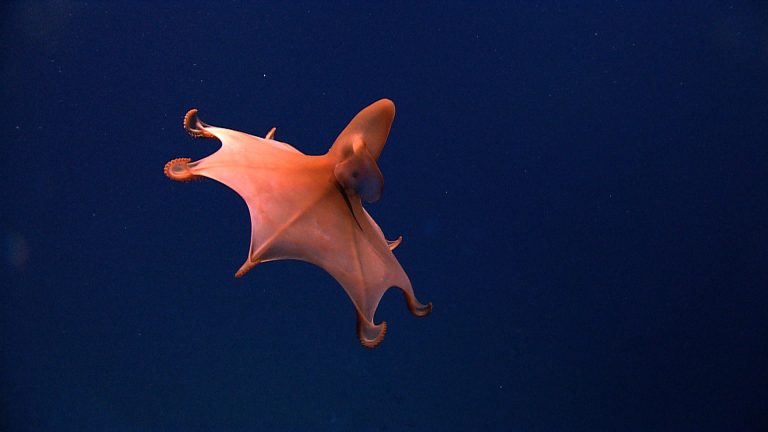
HISTORY OF THE DUMBO OCTOPUS
Although Grimpotheuthis umbrellata was first discovered in 1884, this particular dumbo octopus is still not well known. This species was first described from three specimens: one large specimen taken from the Azores (at 2235 meters depth) and two smaller specimens from off the coasts of Morocco and the Carnaries.
From the two smaller specimens, one is extinct and the other has been identified as an Opisthoteuthis (flapjack octopus). Therefore, one specimen remains for G. umbrellata and it is in poor condition. Most of the characteristics described apply to the genus Grimpotheuthis.
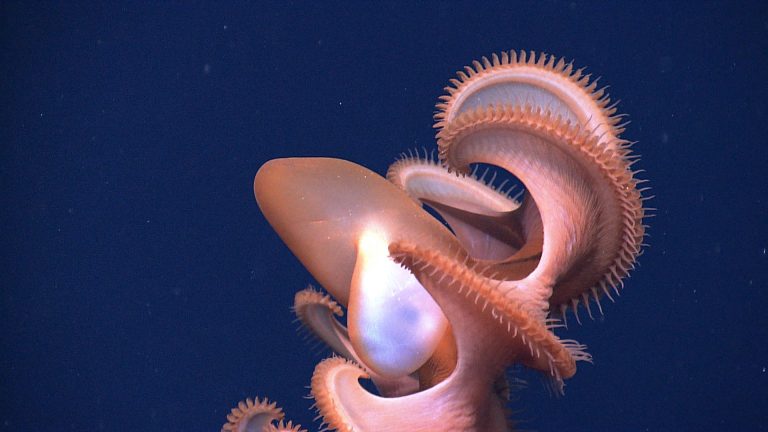
SIZE OF THE DUMBO OCTOPUS
The body is semi-gelatinous with a bell-shaped form. This genus has moderate length arms and moderate lateral fins with a mantle length to 115 mm (4.5 in) and total length to 475 mm (19 in). They have a single row of suckers straddled by cirri.
DUMBO OCTOPUS LIFESPAN
This dumbo octopus is thought to live for 3-5 years.
DISTRIBUTION
There is only a single specimen caught near the Azores from a depth of 2235 meters (1.4 miles).
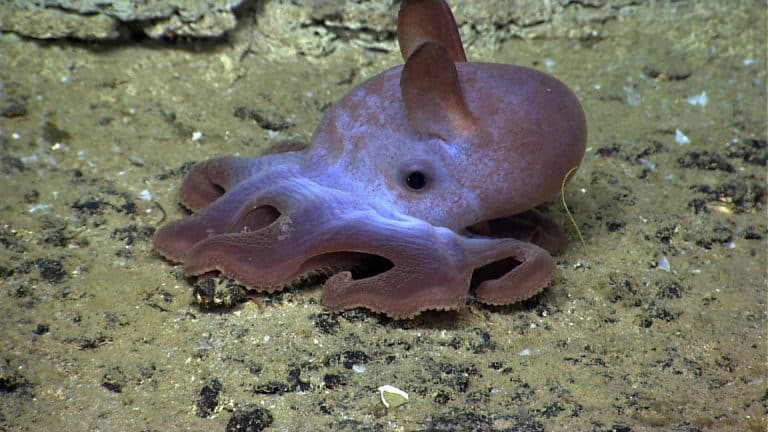
NOAA OKEANOS EXPLORER Program, Gulf of Mexico 2014 Expedition
HABITAT
All Grimpoteuthis species live in the deep ocean. G. umbellata is a benthic species that lives in the lower bathyal and abyssal zones (1110-5400 meters). That’s almost 3.5 miles deep!
DIET
Each sucker (about 65-68 on each arm) has a pair of cirri, which play a key role (along with the suckers) in chemorecepetion, handling small prey, and assisting in transporting prey to the mouth by creating water currents.
The genus Grimpoteuthis has been reported to feed on worms, bivalves, copepods, isopods, amphipods. For most cirrate octopuses, the eyes are large, but it is unknown how important they are for prey and/or predator detection.
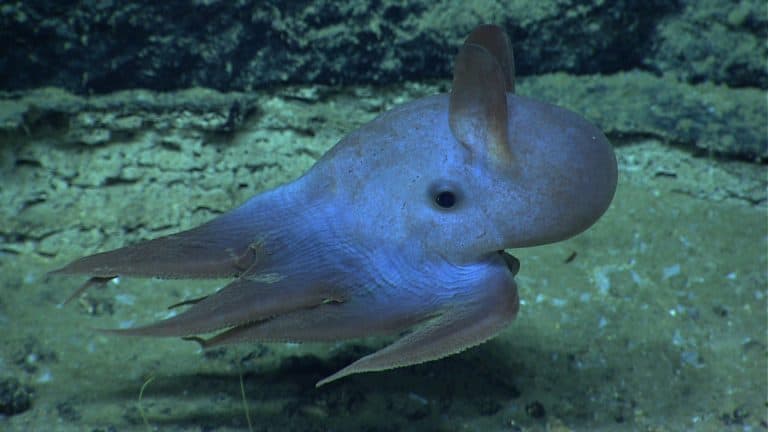
BODY PATTERNS AND BEHAVIORS
Dumbo octopuses are deep-sea cirrate octopuses that lack chromatophores and are therefore not capable of color change. In most species, the skin is pigmented and is orange, red, or purple in color. For Grimpoteuthis, the oral surface of the arms is usually deep purple with the rest of the body pale or unpigmented (some photos do show pigmentation in both oral and dorsal surfaces).
Grimpotheuthis belong to a group known as umbrella octopuses. Umbrella octopuses are characterized by a web of skin between the arms, resembling an opened umbrella when arms are spread. For Grimpotheuthis, their arms are directly connected to the web. They also have a U-shaped shell in their mantle that gives them a bell-shaped appearance like an umbrella.
This genus is commonly recognized by their ear-like fins that stick out from their mantle. They’ve been giving the popular name of “Dumbo octopuses”, “Dumbo octopods” or “Dumboes” in reference to Walt Disney’s movie with the flying elephant.
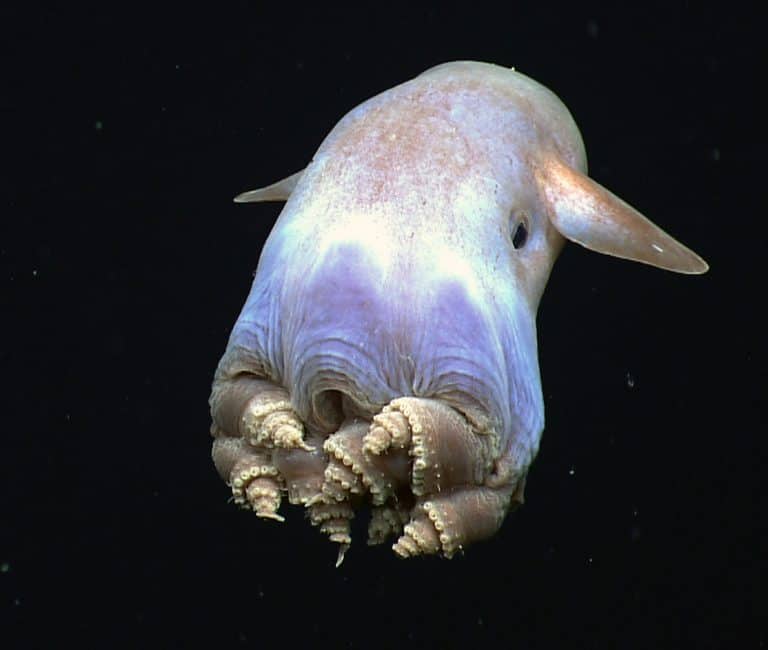
Image courtesy of the NOAA Office of Ocean Exploration and Research, Exploration of the Gulf of Mexico 2014
ATTITUDES AND MODES OF LOCOMOTION
The development of new technology, such as manned submersibles, has opened new horizons for deep sea exploration! The manned submersible Nautile was able to film behavioral observations of Grimpoteuthis at depths between 2702 – 4527 meters (1.7-2.8 miles) on the Mid-Atlantic Ridge.
Scientists observed octopus’ bottom-resting attitude and three modes of locomotion: crawling, take-off, and fin-swimming. Bottom-resting was observed when the octopus’s arms and web were out-spread, fins were extended parallel to the bottom, eyes were open, and mantle erect and pointing backwards at a slight angle. Starting from bottom-resting, octopus would crawl slowly backwards with all arms extended. Once the octopus gained speed, movement of the right and left arms was symmetrical. If the octopus was disturbed, it would take-off from bottom resting or crawling as a sudden escape reaction.
Take-off comprised a single, strong pulsation generated by contraction of the arm crown and was sometimes accompanied by a forceful stroke of the fins. The octopus would pull its body into a fusiform shape, mantle first with the arms trailing behind, and continue by fin-swimming a few meters off the bottom. The number of fin strokes per minute ranged from 4 to 30!
Collins M (2003) IN Jereb P, Roper CFE, Norman MD, Finn JK (eds) (2014) Cephalopods of the world. An annotated and illustrated catalogue of cephalopod species known to date. Volume 3. Octopods and Vampire Squids. FAO Species Catalogue for Fishery Purposes. No. 4, Vol. 3. Rome, FAO. p 255
Collins M, Vecchione M,Young RE (2003) Grimpoteuthis discoveryi Collins 2003. Version 13 May 2003 (under construction):
http://tolweb.org/Grimpoteuthis_discoveryi/20121/2003.05.13 in The Tree of Life Web Project, http://tolweb.org/
Collins M (2008) The genus Grimpoteuthis (Octopoda: Grimpoteuthidae) in the north-east Atlantic, with descriptions of three new species. Zoological Journal of the Linnean Society.139: 93-127
Goncalves JM (1991) The Octopoda (Mollusca: Cephalopoda) of the Azores. Arquipklago. Life and Earth Sciences, 975-81. Angra do Hemlsmo. ISSN0870-6581.
Hochberg, FG, Norman, MD and Finn, JK (2014) Family Cirroctopodidae. IN Jereb P, Roper CFE, Norman MD and J. K Finn JK (eds.) (2014) Cephalopods of the world. An annotated and illustrated catalogue of cephalopod species known to date. Volume 3. Octopods and Vampire Squids. FAO Species Catalogue for Fishery Purposes. No. 4, Vol. 3. Rome, FAO. pp. 245-247.
Gordon JDM, Atkinson RJA, Gibson RN (eds) Oceanography and Marine Biology An Annual Review. Volume 44. 2006. 536 p.
Piertney SB, Huedelot C, Hochberg FH, Collins MA (2003) Phylogenetic relationships among cirrate octopods (Mollusca: Cephalopoda) resolved using mitochondrial 16S ribosomal DNA sequences. Molecular Phylogenetics and Evolution. 27: 348–353
Our mission is simple: We work to inspire wonder of the ocean by educating the world about octopuses.
We work with scientists, educators, and artists to make a global impact.
OctoNation® is a 501(c)(3) Nonprofit Organization